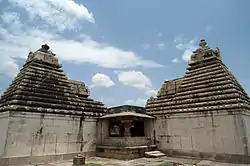Erakeswara Temple, Pillalamarri
Erakeswara Temple is a Saivite Hindu temple located in Pillalamarri, Suryapet district of Telangana, India. The temple was built on the banks of the Musi river in c. 1208 CE by Erakasani, the wife of Bēti Reddi of the Recherla family who were the feudatories of Kakatiyas.[1][2][3][4][5] Erakeswara Temple is one among the three prominent temples located in Pillalamarri village—the other two being Nameswara Temple and Trikuta Temple. The main deity of the temple is Lord Chennakesava, a form of Lord Siva.
| Erakeswara Temple | |
|---|---|
 Pillalamarri Erakeswara Temple | |
| Religion | |
| Affiliation | Hinduism |
| District | Suryapet |
| Deity | Chennakesava Swami |
| Location | |
| Location | Pillalamarri, Suryapet |
| State | Telangana |
| Country | India |
 Location in Telangana | |
| Geographic coordinates | 17.1922°N 79.57356°E |
| Architecture | |
| Type | Kakatiya architecture |
| Completed | c. 1208 CE |
Location
Pillalamarri is located at a distance of 6 km northwest of Suryapet town. Suryapet is located at a distance of 153 km from Hyderabad on the National Highway 65.
History
The temple was built in the early 13th century (c. 1203-1208 CE)[2][6] by the Recherla chiefs who served as the feudatories of Kakatiyas. One inscription notes that Erakasani, the wife of Bēti Reddi of the Recherla family built the temple in 1208 CE in Pillalamarri and installed in it the deity Erakeswara named after herself.[1][3][4][5][7][8] The temple was vandalised during the raids of Alauddin Khilji into the Deccan region in the early 14th century. An inscription dated to 1357 CE records the re-establishment of Lord Erakeswara by a local feudatory chief serving Kapaya Nayaka of Musunuri Nayaka dynasty.[9]
Prominent stone inscriptions in Telugu about the history of the temple and of Pillalamarri are displayed in the temple premises. One of the stone inscriptions is dated to 1195 CE (Saka. 1117) and mentions the rule of Pratapa Rudra I. Another stone inscription dates to 1208 CE (Saka. 1130) and makes a reference to the reign of Ganapati Deva.[10][11]
Architecture
The architectural style of the temple is close to Ramappa temple and Kota Gullu, other Kakatiya era temples. The temple is placed on an upapitha and is cruciform in shape.[12][13] It has three porticos in the east, north and south and a garbhalaya in the west. The sikhara on the inner sanctum (garbhagudi) is made of brick and lime and is decorated all over by miniature turrets. It is said that the stone used in temple construction has interesting acoustic properties. When the temple stone is tapped with a coin, it sounds like metal.[13] The temple has intricately carved pillars and walls. The temple walls are painted with frescoes.
Gallery










 Stone inscription in Medieval Telugu
Stone inscription in Medieval Telugu
References
- Rao, P. R. Ramachandra (2005). The Splendour of Andhra Art. Akshara. p. 86.
- "Monuments - Archaeology and Museums". tsdam.com. Retrieved 28 October 2020.
- Rao, M. Rama (1966). Select Kākatīya Temples. Sri Venkatesvara University. p. 91.
- Ganapathi, Racharla (2000). Subordinate Rulers in Medieval Deccan. Bharatiya Kala Prakashan. p. 155. ISBN 978-81-86050-53-8.
- Kumari, V. Anila (1997). The Andhra Culture During the Kakatiyan Times. Eastern Book Linkers. p. 3. ISBN 978-81-86339-15-2.
- "Telangana Protected Monuments List - Heritage Act 2017" (PDF). p. 40.
- Mukherjee, Amitabha (1996). Women in Indian Life and Society. Punthi Pustak and Institute of Historical Studies. p. 89. ISBN 978-81-85094-97-7.
- Suryakumari, A. (1982). The Temple in Andhradesa. Sarvodaya Ilakkiya Pannai. p. 35.
- Sarma, Mukkamala Radhakrishna (1972). Temples of Telingāṇa: The Architecture, Iconography, and Sculpture of the Cāḷukya and Kākatīya Temples. Booklinks Corporation. p. 100.
- "PillalaMarri Temple, Telangana Tourism, TS". tstourism.co.in. Retrieved 28 October 2020.
- Singh, B. Satyanarayana (1999). The Art and Architecture of the Kākatīyas. Bharatiya Kala Prakashan. p. 84. ISBN 978-81-86050-34-7.
- Arch. Series. Government of Andhra Pradesh, Department of Archaeology. 1960. p. 27.
- Chatterjee, Saurabh. "A jewel in a nondescript town". Telangana Today. Retrieved 28 October 2020.
External links
- "Pillalamarri Temples". Retrieved 29 October 2020.
- "Heritage Temple Cluster of Suryapet - Department of Heritage Telangana". Retrieved 29 October 2020.
- "Pillalamarri Erakeswara Swamy Temple - Mandirinfo". Retrieved 29 October 2020.
.jpg.webp)



